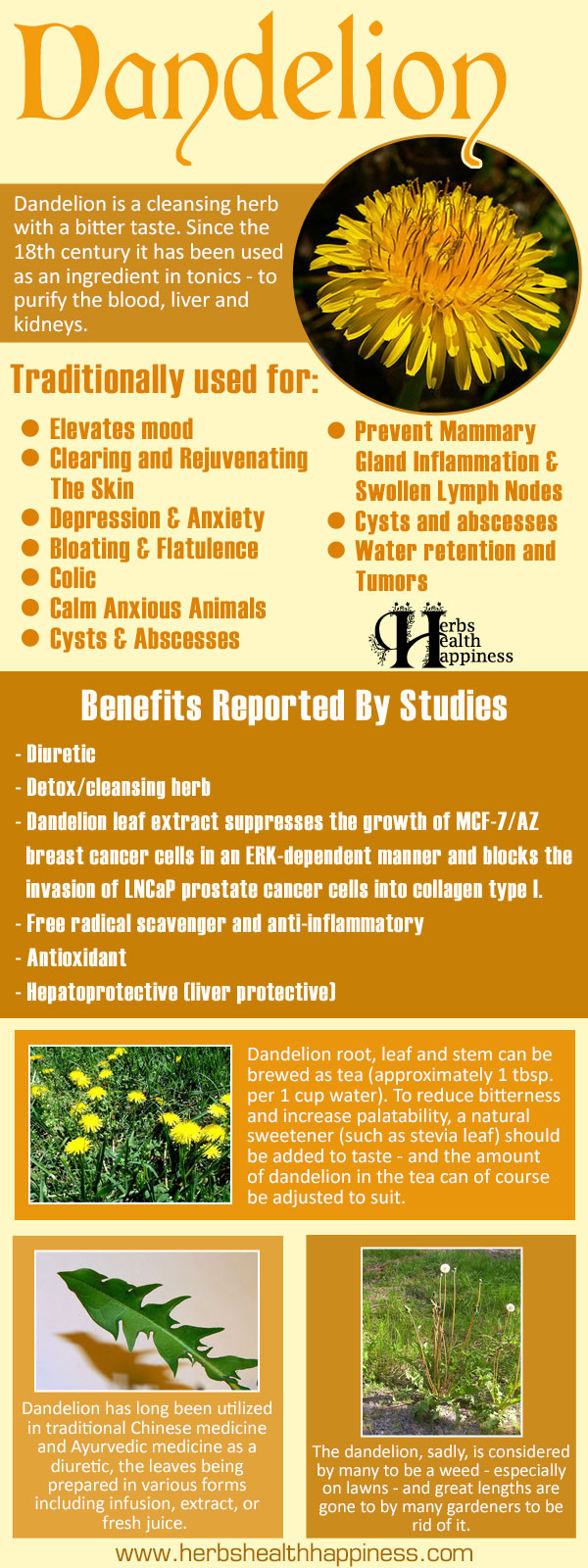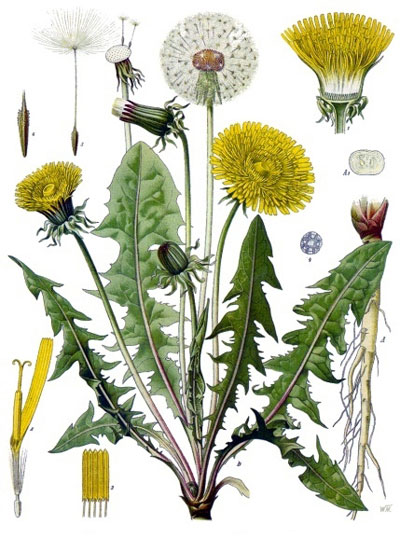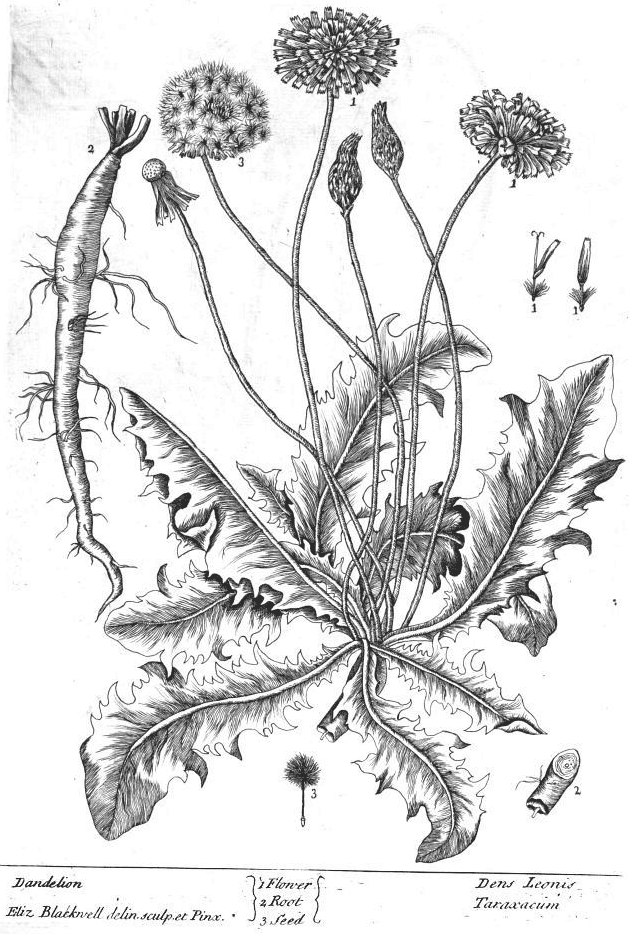Dandelion

Dandelion Uses and Benefits - image to repin / share
Infographic: herbshealthhappiness.com. Image credits: See foot of article
Dandelion (Taraxum officinale / Taraxacum erythrospermum) is a very well known plant that grows all over the world. Loved especially by children, it is famous for its bright yellow flower head, white seed head (consisting of numerous tiny "seed parachutes") and its bright green serrated leaves.
The dandelion, sadly, is considered by many to be a weed - especially on lawns - and great lengths are gone to by many gardeners to be rid of it. The herbalist on the other hand has an entirely different opinion of the dandelion and considers it a plant of great value with many virtuous properties.
Dandelion - Herbal Uses
Dandelion is a cleansing herb with a bitter taste. Since the 18th century it has been used as an ingredient in tonics - to purify the blood, liver and kidneys. It has also been used to elevate mood. Despite its potential to relieve symptoms of depression and anxiety, great pains have been taken - since the onset of suburban living - to remove it from lawns across America. [1] Dandelion is considered a potent diuretic - hence one of its ancient English names "Pissa-bed"!
Dandelion is, interestingly, higher in nutrient content than most vegetables. Taraxum officinale and Taraxacum erythrospermum are both edible in their entirety. The dandelion root, leaf, and stem can be taken as a tea or tincture to bring about feelings of well-being in times of stress. In Victorian times the leaves were eaten in salads and sandwiches - and they also may be boiled / steamed.
Dandelion root, leaf and stem can be brewed as tea (approximately 1 tbsp. per 1 cup water). To reduce bitterness and increase palatability, a natural sweetener (such as stevia leaf) should be added to taste - and the amount of dandelion in the tea can of course be adjusted to suit.
Dandelion is considered a beauty aid for its ability to purify and cleanse; when taken regularly it can aid in clearing and rejuvenating the skin. Dandelion is said to have been used for centuries to improve renal elimination, [2] to relieve feelings of bloat and flatulence, and to help with childhood ailments such as colic (dandelion can be safely administered to children by their medical practitioner or parent). As a complementary treatment, it is sometimes used by veterinarians to calm anxious animals.
In Ayurveda (traditional Indian medicine), dandelion leaf is used to to treat and prevent mammary gland inflammation and swollen lymph nodes, whereas the root is used to treat disorders of the liver and kidneys. Dandelion leaves are used by practitioners of both Ayurvedic and Chinese medicine to treat cysts and abscesses, water retention and tumors. [3]
Dandelion - Scientific Studies
Dandelion as detox herb: In clinical trials dandelion has been found to increase bile flow (which can prevent gallstones and promote detoxification of the lymph system). [4]
Dandelion as anti-cancer agent: There is encouraging evidence that dandelion (Taraxacum) inhibits the growth and development of a wide range of cancer types and influences their metastasizing behavior. The 2008 study of Sigstedt et al. provided scientific data on Taraxacum officinale that highly suggest that dandelion extracts or their constituents exert anticancer activities. In this study, three aqueous extracts prepared from the mature dandelion leaves, flowers, and roots were investigated for their activities on tumor progression and invasion. The results of this study had demonstrated that dandelion leaf extract suppresses the growth of MCF-7/AZ breast cancer cells in an ERK-dependent manner and blocks the invasion of LNCaP prostate cancer cells into collagen type I. On the other hand, dandelion root extract blocks the invasion of MCF-7/AZ breast cancer cells. [5]
The flower extract of dandelion also holds striking antioxidant activity in both biological and chemical models, as shown in a 2005 Canadian study in which extended lag phase and reduced propagation rate were observed in the oxidation of linoleic acid emulsion plus dandelion flower extract. In this study, the extract from dandelion had suppressed superoxide and hydroxyl radicals. [6] All of these results translate to dandelion being a potential novel anticancer agent.
Dandelion as diuretic: According to the European Scientific Cooperative for Phytotherapy (ESCOP) - as per historical records and recent clinical studies - dandelion has caused weight loss of up to 30% in mice and rats. Although dandelion has not been the object of extensive pharmacological analysis, its exceptionally high potassium content has prompted a number of related studies which determined that excess potassium may cause diuretic action (and thus loss of weight). This may be useful against water retention but is not the same as actual fat loss. [7]
Dandelion has long been utilized in traditional Chinese medicine and Ayurvedic medicine as a diuretic, [7] the leaves being prepared in various forms including infusion, extract, or fresh juice. [8] Having the study participants ingest high-quality leaf hydroethanolic extract of dandelion (Taraxacum officinale), Clare, Conroy, and Spelman (2009) explored the effects of dandelion extract on urinary frequency and volume and found a significant (p < 0.05) increase on urinary frequency after the first dose and a significant (p < 0.001) increase as regards excretion ratio after the second dose for the entire population (n = 17) in their study. [9] Being an herb of diuresis, dandelion proves to be of value in the treatment of conditions where induction of diuresis is of essence, such as in several heart diseases in which the reduction of blood pressure is achieved by decreasing the amount of salt and water in the body through the administration of diuretics or in edema and certain types of kidney or liver diseases. [10]

Dandelion - Taraxacum officinale
Image from an old book of medicinal plants
Dandelion as free radical scavenger and anti-inflammatory: Dandelion also exerts a hepatoprotective effect against acetaminophen-induced toxicity through scavenging mechanisms against reactive oxygen species (ROS) and reactive nitrogen species (RNS). In a recent study, the extract from dandelion had demonstrated an antioxidant and scavenging activity in vitro against 2,2-diphenyl-1-picrylhydrazyl and nitric oxide radicals. [11] Choi et al. (2010) in their study had cited the positive hypolipidemic and antioxidant effects of dandelion, specifically the root and leaves, concluding that dandelion root and leaf could protect one against oxidative stress–associated atherosclerosis. [12] Dandelion leaves downregulate nitric oxide, prostaglandin E(2), and proinflammatory cytokines (tumor necrosis factor-α and interleukin-1β) and suppress the expression of iNOS and COX-2 by inactivating the MAP kinase signal pathway, making dandelion an anti-inflammatory agent. [13]
Dandelion - Active Components / Phytochemistry
A broad spectrum of flavonoids such as caffeic acid, chlorogenic acid, luteolin, and luteolin 7-glucoside can be isolated from dandelion. In the study conducted by Williams, Goldstone, and Greenham (1996), chicoric acid, monocaffeyltartaric acid, and chlorogenic acid were derived from the whole plant (chicoric acid and monocaffeyltartaric acid being the major phenolic constituents in flowers, roots, leaves, and involucral bracts), whereas cichoriin and esculin were found in the leaf extracts. [14]
Dandelion in old Herbals & Pharmocopœia
Elizabeth Blackwell's "A Curious Herbal" (1751): 1. The leaves of this plant lie on ye Groud; the Pedikels or Pipes on which the Flowers grow are about six or eight inches high; and the flowers yellow. The root grows about a Finger thick, and eight inches long, full of a white bitter Milk. 2. It Grows almost everywhere in Fallow Ground and flowers most Months in the year. 3. The Roots and Leaves are used, as cooling, aperative, provoking urine, and strengthening ye stomach, and are much eat as a Sallad in the Spring.
John Hill - "The Family Herbal" (1812):Another of our wild plants too common to need much description. The leaves are very long, somewhat broad, and deeply indented at the edges. The stalks are naked, hollow, green, upright, and six, eight, or ten inches high; one flower stands on each, which is large, yellow, and composed of a great quantity of leaves, and seeds which follow this have a downy matter affixed to them. The whole head of them appears globular. The root is long, large, and white. The whole plant is full of a milky juice, the root most of all. This runs from it when broken, and is bitterish, but not disagreeable.
The root, fresh gathered and boiled, makes an excellent decoction to promote urine, and bring away gravel. The leaves may be eaten as salad when very young, and if taken this way in sufficient quantity, they are good against scurvy.
William Thomas Fernie - "Herbal Simples" (1895): DANDELION - Owing to long years of particular evolutionary sagacity in developing winged seeds wafted from the silky pappus of its ripe flowerheads over wide areas of land, the Dandelion exhibits its handsome golden flowers in every field and on every ground plot throughout the whole of our country. They are to be distinguished from the numerous hawkweeds, by having the outermost leaves of their outer cup bent downwards whilst the stalk is coloured and shining. The plant leaves have jagged edges which resemble the angular jaw of a lion fully supplied with teeth; or, some writers say, the herb has been named from the heraldic lion which is vividly yellow, with teeth of gold-in fact, a dandy lion!
In some of our provinces the herb is known as Swinesnout; whilst again in Devon and Cornwall it is called the Dashelflower. Botanically it belongs to the composite order, and is named Taraxacum Leontodon, or eatable, and lion-toothed. This latter when Latinised is dens leonis, and in French dent de lion. The Dandelion, which is a wild sort of succory, was known to Arabian physicians, since Avicenna of the eleventh century mentions it as taraxacon. It is found throughout Europe, Asia, and North America; possessing a root which abounds with milky juice, and which varies in character according to the season in which the plant is gathered.
During the winter the sap is thick, sweet, and albuminous; but in summer time it is bitter, and acrid. Frost causes the bitterness to diminish, and sweetness to take its place; but after the frost this bitterness returns, and is intensified. The root is at its best for yielding juice about November. Chemically the active ingredients of the herb are "taraxacin" and "taraxacerine," with inulin (a sort of sugar), gluten, gum, albumen, potash, and an odorous resin, which is commonly supposed to stimulate the liver, and the biliary organs.
Probably this reputed virtue was assigned at first to the plant largely on the doctrine of signatures, because of its bright yellow flowers of a bilious hue. But skilled medical provers who have experimentally tested the toxical effects of the Dandelion plant have found it to produce, when taken in excess, troublesome indigestion, characterised by a tongue coated with a white skin which peels off in patches, leaving a raw surface, whilst the kidneys become unusually active, with profuse night sweats, and an itching nettle rash. For these several symptoms when occurring of themselves, a combination of the decoction, and the medicinal tincture will be invariably curative.
To make a decoction of the root, one part of this dried and sliced should be gently boiled for fifteen minutes in twenty parts of water, and strained off when cool. It may be sweetened with brown sugar, or honey, if impalatable when taken alone, several teacupfuls being given during the day.
The tops of the roots dug out of the ground, with the tufts of the leaves remaining thereon and blanched by being covered in the earth as they grow, if gathered in the spring, are justly esteemed as an excellent vernal salad. It was with this homely fare the good wise Hecate entertained Theseus, as we read in Evelyn's Acetaria. Bergius says he has seen intractable cases of liver congestion cured, after many other remedies had failed, by the patients taking daily for some months, a broth made from Dandelion roots stewed in boiling water, with leaves of Sorrel, and the yelk [sic] of an egg; though (he adds) they took at the same time cream of tartar to keep their bodies open.
The medicinal tincture of Dandelion is made from the entire plant, gathered in summer, employing proof spirit which dissolves also the resinous parts not soluble in water. From ten to fifteen drops of this tincture may be taken with a spoonful of water three times in the day.
Of the freshly prepared juice, which should not be kept long as it quickly ferments, from two to three teaspoonfuls are a proper dose. The leaves when tender and white in the spring are taken on the Continent in salads, or they are blanched, and eaten with bread and butter, Parkinson says: "Whoso is drawing towards a consumption, or ready to fall into a cachexy, shall find a wonderful help from the use thereof, for some time together." Officially, according to the London College, are prepared from the fresh dried roots collected in the autumn, a decoction (one ounce to a pint of boiling water), a juice, a fresh extract, and an inspissated [i.e. thickened] liquid extract.
Because of its tendency to provoke involuntary urination at night, the Dandelion has acquired a vulgar suggestive appellation which expresses this fact in most homely terms: quasi herba lectiminga, et urinaria dicitur; and this not only in our vernacular, but in most of the European tongues: quia plus lotii in vesica in derivat quam puerulis retineatur prœsertim inter dormiendum.
At Gottingen, the roots are roasted and used instead of coffee by the poorer folk; and in Derbyshire the juice of the stalk is applied to
remove warts. The flower of the Dandelion when fully blown is named Priest's Crown (Caput monachi), from the resemblance of its naked receptacle after the
winged seeds have been all blown away, to the smooth shorn head of a Roman cleric :-
"The Dandelion this:
A college youth that flashes for a day
All gold: anon he doffs his gaudy suit,
Touched by the magic hand of Bishop grave,
And all at once by commutation strange
Becomes a reverend priest: and then how sleek!
How full of grace! with silvery wig at first
So nicely trimmed, which presently grows bald.''
Other names for Dandelion, Past or Present
English - Swinesnout, Dashelflower, Pissa-bed
Latin - Taraxacum officinale; also Taraxacum Leontodon, Dens Leonis
French - Dents de Lyon
German - Löwenzahn. (Pfaffenblatt, Runnichstopff - archaic)
Dutch - Papencruyt
Spanish - Diente de Lion
Italian - Dente di Cane, Piscia al letto
References:
[1] Czygan, Franz-Christian, Dietrich Frohne and Karl Hiller. 2004. Herbal Drugs and Phytopharmaceuticals: A Handbook for Practice on a Scientific Basis. Brinkman, Josef A. and Lindenmaier, Michael P. trans. medpharm GmbH Scientific Publishers: Stuttgart, Germany.
[2] Frauke, Gaedcke, Barbara Steinhoff and Helga Blasius. 2003. Herbal Medicinal Products: Scientific and Regulatory Basis for Development, Quality Assurance and Marketing Authorisation. medpharm GmbH Scientific Publishers: Stuttgart, Germany.
[3] Fugh-Berman, Adriane. 2003. The 5-Minute Herb and Dietary Supplement Guide. Lippincot Williams & Wilkins: Philadelphia, PA.
[4] Stover, Sarah Avant. 2011. The Way of the Happy Woman: Living the Best Year of Your Life. The New World Library: Novato, CA.
[5] Sigstedt S. C. et al. (2008). Evaluation of aqueous extracts of Taraxacum officinale on growth and invasion of breast and prostate cancer cells. International Journal of Oncology, 32(5): 1085–1090. Retrieved 1 March 2013 from https://www.ncbi.nlm.nih.gov/pubmed/18425335
[6] Hu C. & Kitts D. D. (2005). Dandelion (Taraxacum officinale) flower extract suppresses both reactive oxygen species and nitric oxide and prevents lipid oxidation in vitro. Phytomedicine, 12(8): 588–597. Retrieved 1 March 2013 from https://www.ncbi.nlm.nih.gov/pubmed/16121519
[7] Khalsa, Karta Purkh Singh and Michael Tierra. 2008. The Way of Ayurvedic Herbs: The Most Complete Guide to Natural Healing and Health with Traditional Ayurvedic Herbalism. Lotus Press: Twin Lakes, WI.
[8] European Scientific Cooperative on Phytotherapy. (2003). ESCOP Monographs: The Scientific Foundation for Herbal Medicinal Products (2nd). Exeter, UK: European Scientific Cooperative on Phytotherapy
[9] Clare B. A., Conroy R. S., Spelman K. (2009). The diuretic effect in human subjects of an extract of Taraxacum officinale folium over a single day. Journal of Alternative and Complementary Medicine, 15(8): 929–934. doi: 10.1089/acm.2008.0152. Retrieved 1 March 2013 from https://www.ncbi.nlm.nih.gov/pmc/articles/PMC3155102/#B6
[10] Iliades C. Diuretics: Vital Meds for Heart Disease. Retrieved 1 March 2013 from https://www.everydayhealth.com/heart-disease/diuretics-for-heart-disease.aspx
[11] Colle D. et al. (2012). Antioxidant properties of Taraxacum officinale leaf extract are involved in the protective effect against hepatoxicity induced by acetaminophen in mice. Journal of Medicinal Food, 15(6): 549–556. doi: 10.1089/jmf.2011.0282. Retrieved 1 March 2013 from https://www.ncbi.nlm.nih.gov/pubmed/22424457
[12] Choi U. K. et al. (2010). Hypolipidemic and antioxidant effects of dandelion (Taraxacum officinale) root and leaf on cholesterol-fed rabbits. International Journal of Molecular Sciences, 11(1): 67–78. doi: 10.3390/ijms11010067. Retrieved 1 March 2013 from https://www.ncbi.nlm.nih.gov/pubmed/20162002
[13] Koh Y. J., Cha D. S., Ko J. S., Park H. J., & Choi H. D. (2010). Anti-inflammatory effect of Taraxacum officinale leaves on lipopolysaccharide-induced inflammatory responses in RAW 264.7 cells. Journal of Medicinal Food, 13(4): 870–878. doi: 10.1089/jmf.2009.1249. Retrieved 1 March 2013 from https://www.ncbi.nlm.nih.gov/pubmed/20673058
[14] Williams C. A., Goldstone F., & Greenham J. (1996). Flavonoids, cinnamic acids and coumarins from the different tissues and medicinal preparations of Taraxacum officinale. Phytochemistry, 42(1): 121–127. Retrieved 1 March 2013 from https://www.ncbi.nlm.nih.gov/pubmed/8728061/
Dandelion Illustration

Dandelion
Main article researched and created by Kelsey Wambold. Scientific studies report by Dan Ablir -
© herbshealthhappiness.com
Infographic Image Sources:
https://en.wikipedia.org/wiki/File:DandelionFlower.jpg
https://commons.wikimedia.org/wiki/File:Taraxacum,_ArmAg_(2).jpg
https://en.wikipedia.org/wiki/File:TaxicumLeaf.jpg
https://en.wikipedia.org/wiki/File:Eightyfivedandelion.JPG
(Creative Commons)


1. Famous Chef Sheds 60lbs Researching New Paleo Recipes: Get The Cookbook FREE Here
2. #1 muscle that eliminates joint and back pain, anxiety and looking fat
3. Drink THIS first thing in the morning (3 major benefits)
4. [PROOF] Reverse Diabetes with a "Pancreas Jumpstart"
5. Why Some People LOOK Fat that Aren't
6. Amazing Secret Techniques To Protect Your Home From Thieves, Looters And Thugs
7. The #1 WORST food that CAUSES Faster Aging (beware -- Are you eating this?)
If you enjoyed this page:



























